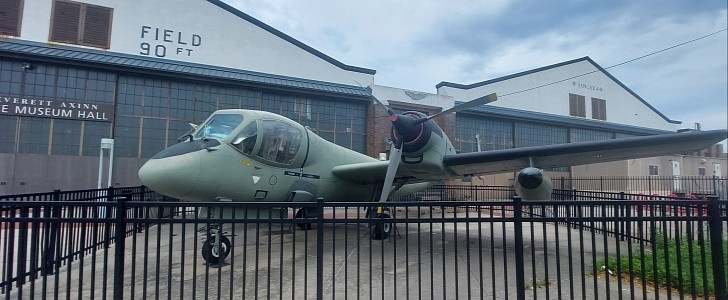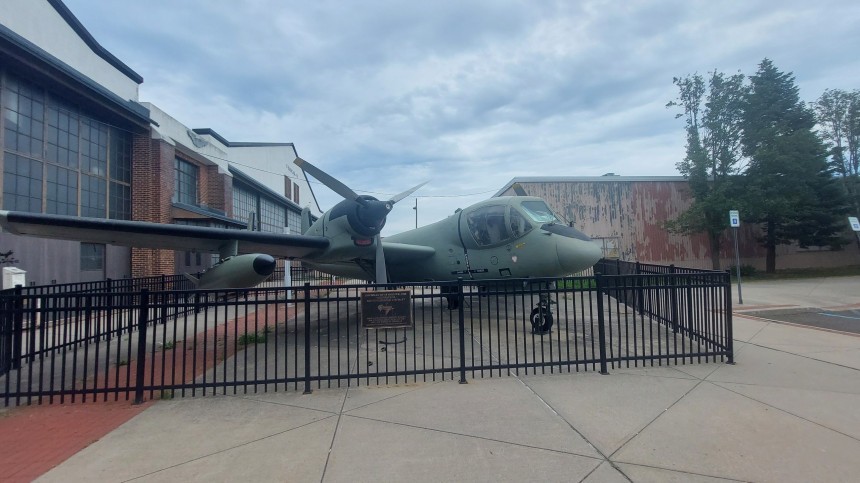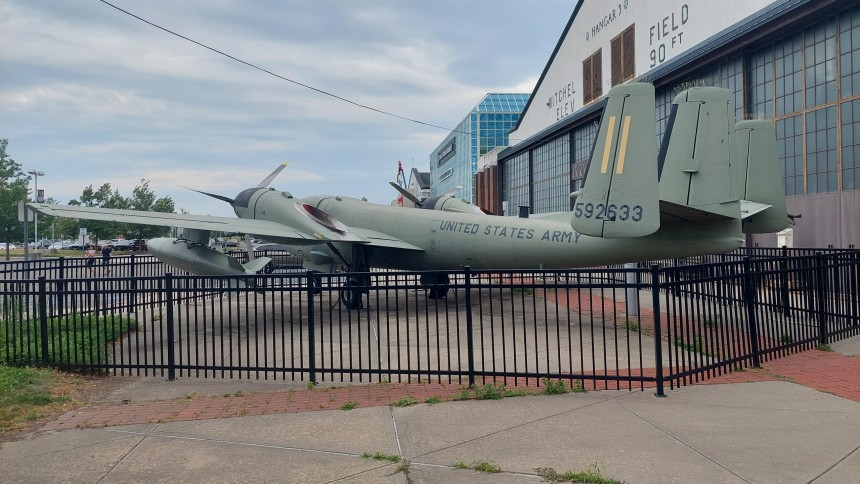If you know anything about Grumman, it's probably because of their iconic Navy Cat line of carrier-based fighter planes. Heavyweights of their day like the F4F Wildcat, F6F Hellcat, F-11 Tiger, and F-14 Tomcat form a legacy that'd be the envy of any aerospace company.
But outside of its duties providing navies worldwide with top-quality airplanes, they've found work elsewhere on several occasions. Since the U.S. Air Force separated from the Army post World War Two, aviation has been a realm seldom under the jurisdiction of the Army. But not always, as is evident by the Grumman OV-1 Mohawk. A delightfully adorable little twin-engine turboprop attack and observation airplane that packed enough wallop to shoot down jets.
Designed to replace the even smaller, cuter, but antiquated Cessna O-1 Bird Dog, the OV-1 Mohawk was one of Grumman's rare non-Navy projects. The type was designed not for raw speed or dogfighting but to be low and slow ground-based Close Air Support (CAS) airplanes. Granted, Navy, Air Force, and Marine Corps variants meant to operate from small escort carriers were proposed.
But like a couple bickering over what to eat for dinner, the Navy and Marines didn't care for the Mohawk's complicated sensor and radar array, and the Air Force lamented its armament capability. In the end, the ostensibly non-air-oriented branch of the American military wound up in possession of Grumman's new airplane.
Its first flight was on April 14th, 1959. Pilots raved about its cockpit visibility, reasonably good maneuverability, and surprising ground attack weapons loadout. Alongside a host of helicopters and unarmed light fixed-wing airplanes in Army service, the Mohawk was about to be thrust into combat in a war some argue America could have never truly won.
America's entry into Vietnam was murky at best. But in the crucible of combat, the Mohawk proved to be a durable and capable Army flying machine. With a simple thick, straight wing configuration and twin Lycoming T53-L-701 turboprops with 1,400 shaft-hp (1,000 kW) each, the Mohawk could loiter over enemy territory and locate the precise location of Vietcong ground forces, artillery, and armored vehicles. From there, Mohawks could either order in a larger airstrike or swoop in with XM14 .50 cal. (12.7 mm) caliber gun pods, M159 unguided rocket pods, and unguided bombs up to 500 lbs (226.8 kg).
But it was not strafing ground targets where the OV-1 had its greatest moment. Instead, it was doing something it was never intended to do. Something that may have seriously ticked off the Air Force, Navy, and Marines if it were to be made widely known. In 1968, in the skies over South Vietnam, U.S. Army Captain Ken Lee was in formation with a flight of Mohawks when the flight element was attacked by something no Mohawk pilot ever wanted to see.
It was a shiny MiG-17 "Fresco" high subsonic jet fighter capable of shooting down much scarier airplanes than the adorable little Mohawk. The MiG swooped by Ken Lee's canopy, launching a torrent of 23 and 37mm cannon fire. One well-aimed burst could have shredded any one of the formations of Mohawks in seconds. Miraculously, Lee's OV-1 survived the onslaught for long enough for the MiG to loop back around and try again.
This time, the MiG's cannon fire missed as it passed directly into the target pipper of the Mohawk's ground fire calibrated machine gun pod. With a quick pull of the trigger, Lee unleashed a barrage of machine gun fire that pummeled the Fresco's wings, tail, and engine. Just like that, the MiG burst into flames and careened into the jungle below. It was the first time since before the U.S. Army/Air Force split that an Army aviator had earned an air-to-air kill.
Because of something called the Key West Agreement, in which air-to-air combat was delegated solely to the Air Force, Marines, and Navy, Army officers informed of Ken Lee's shootdown made a great effort to conceal the victory from higher-ups in other branches of the military. Lest it was used as justification to transfer the Army's fleet of Mohawks into other branches. The shootdown wasn't formally acknowledged until 2007.
The Mohawk would continue service with both the U.S. and Argentinian Armed Forces after Vietnam. It even lasted long enough to see service in Operation Desert Storm. Today, Mohawks are on display across America, with some in Argentina. This particular example sits as a gate guard outside the Cradle of Aviation Museum in Garden City, New York, where you can get a nice, up-close look at it.
Designed to replace the even smaller, cuter, but antiquated Cessna O-1 Bird Dog, the OV-1 Mohawk was one of Grumman's rare non-Navy projects. The type was designed not for raw speed or dogfighting but to be low and slow ground-based Close Air Support (CAS) airplanes. Granted, Navy, Air Force, and Marine Corps variants meant to operate from small escort carriers were proposed.
But like a couple bickering over what to eat for dinner, the Navy and Marines didn't care for the Mohawk's complicated sensor and radar array, and the Air Force lamented its armament capability. In the end, the ostensibly non-air-oriented branch of the American military wound up in possession of Grumman's new airplane.
Its first flight was on April 14th, 1959. Pilots raved about its cockpit visibility, reasonably good maneuverability, and surprising ground attack weapons loadout. Alongside a host of helicopters and unarmed light fixed-wing airplanes in Army service, the Mohawk was about to be thrust into combat in a war some argue America could have never truly won.
But it was not strafing ground targets where the OV-1 had its greatest moment. Instead, it was doing something it was never intended to do. Something that may have seriously ticked off the Air Force, Navy, and Marines if it were to be made widely known. In 1968, in the skies over South Vietnam, U.S. Army Captain Ken Lee was in formation with a flight of Mohawks when the flight element was attacked by something no Mohawk pilot ever wanted to see.
It was a shiny MiG-17 "Fresco" high subsonic jet fighter capable of shooting down much scarier airplanes than the adorable little Mohawk. The MiG swooped by Ken Lee's canopy, launching a torrent of 23 and 37mm cannon fire. One well-aimed burst could have shredded any one of the formations of Mohawks in seconds. Miraculously, Lee's OV-1 survived the onslaught for long enough for the MiG to loop back around and try again.
This time, the MiG's cannon fire missed as it passed directly into the target pipper of the Mohawk's ground fire calibrated machine gun pod. With a quick pull of the trigger, Lee unleashed a barrage of machine gun fire that pummeled the Fresco's wings, tail, and engine. Just like that, the MiG burst into flames and careened into the jungle below. It was the first time since before the U.S. Army/Air Force split that an Army aviator had earned an air-to-air kill.
The Mohawk would continue service with both the U.S. and Argentinian Armed Forces after Vietnam. It even lasted long enough to see service in Operation Desert Storm. Today, Mohawks are on display across America, with some in Argentina. This particular example sits as a gate guard outside the Cradle of Aviation Museum in Garden City, New York, where you can get a nice, up-close look at it.










